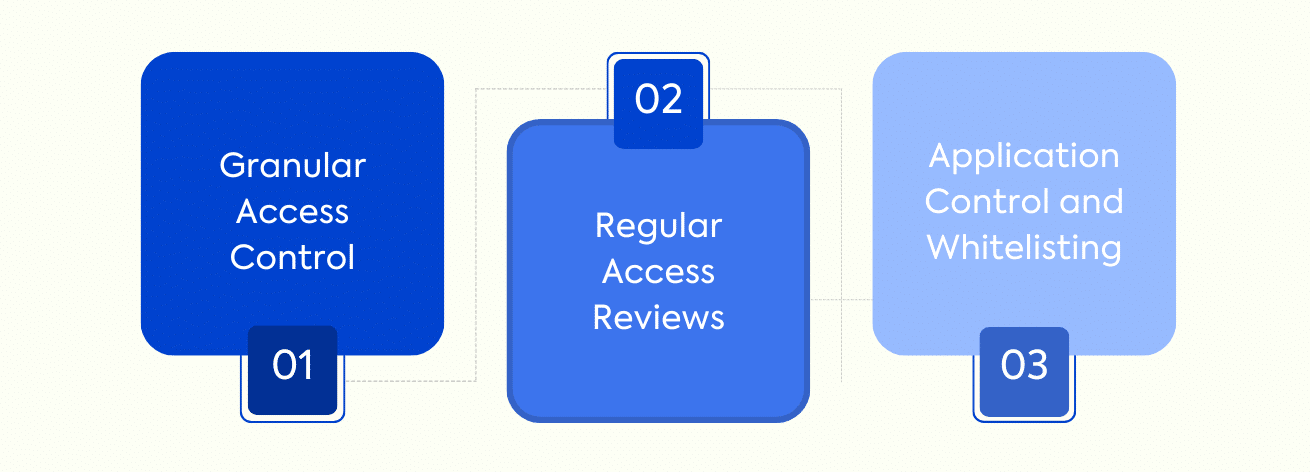
- Home
- Services
- Solutions
- Compliance
- RBI Cyber Security Framework For Banks
- SEBI Cyber Security & Cyber Resilience Framework
- UIDAI – AUA KUA Compliance Security
- RBI Guidelines for Payment Aggregators & Payment Gateways
- RBI Cyber Security Framework For Urban Cooperative Banks
- RBI Guidelines for cyber security in the NBFC Sector
- SAR Audit
- ISO27001
- PCI DSS
- GDPR
- Hipaa Audit
- SOC2 Assessment
- Resources
- Company
- Contact
Endpoint Security: The Least Privilege Approach
With endpoints being the primary targets for malicious attacks, adopting a robust security strategy is crucial. One such approach gaining prominence is “The Least Privilege Approach.” In this blog, we delve into the significance of endpoint security and explore how the least privilege model can fortify your organization’s defense against potential cyber threats.
What is Endpoint Security?
Endpoint security serves as the first line of defense against cyber threats that target individual devices within a network. Endpoints encompass a wide range of devices, including laptops, smartphones, tablets, and IoT devices, making them susceptible to various attack vectors. Endpoint security safeguards entry points on devices from cyber threats. It’s evolved beyond antivirus to counter sophisticated malware, including insider risks. Organizations face dangers from various sources, making endpoint security crucial in defending networks. Modern solutions swiftly detect, analyze, and counter ongoing attacks, collaborating with other technologies for rapid threat response.
Understanding the Least Privilege Principle
The Least Privilege Principle (LPP) is a time-honored security concept that grants users the minimum level of access required to perform their designated tasks and nothing more. In essence, users are only given the required privileges to perform their job functions efficiently, thereby limiting their access to sensitive resources and avoiding any potential abuse of over permissive actions. By adhering to this principle, the attack surface is significantly reduced, mitigating the impact of potential security breaches.
Key Principles of the Least Privilege Approach

- Granular Access Control: The least privilege model advocates for fine-grained access control, where permissions are assigned based on job roles, responsibilities, and specific tasks. This ensures that users only have access to the resources that are directly relevant to their job functions.
- Regular Access Reviews: Implementing the least privilege approach requires periodic access reviews. Regularly evaluating and adjusting user privileges based on changing job roles and responsibilities is crucial to maintaining a secure environment.
- Application Control and Whitelisting: By employing application whitelisting, only authorized and trusted applications can run on endpoints. This measure significantly reduces the risk of malware and unauthorized software installations.
Latest Statistics on Endpoint Security
As of the first half of 2023, endpoint security continues to be a critical concern for organizations worldwide. The following statistics highlight the prevailing challenges and trends in this domain:
- The global endpoint security market is projected to reach over 13 billion U.S. dollars in 2023 and keeps growing as cybersecurity is of paramount importance to businesses today.
- Over 60% of surveyed organizations reported experiencing insider-related security incidents in the past year.
- Forrester Researcher estimates that 80% of data breaches involve privileged credentials
- Only 34% of organizations have fully adopted the least privilege principle.
- Around 80% of surveyed organizations listed endpoint security compliance as a top concern.
Benefits of Embracing the Least Privilege Model
- Minimize Attack Surface: With limited access, the attack surface is greatly reduced, making it significantly harder for cybercriminals to gain unauthorized entry.
- Containment of Threats: In the event of a security breach, the damage can be localized since the compromised account or application will have restricted access.
- Enhanced Data Protection: Sensitive data remains shielded from unauthorized access, reducing the risk of data leaks and breaches.
- Regulatory Compliance: Many data protection regulations, such as GDPR and HIPAA, mandate the implementation of the least privilege principle, making it crucial for compliance.
- Improved Endpoint Performance: Unnecessary privileges can lead to resource wastage and system instability. By limiting access, endpoints can perform optimally.
Implementing the Least Privilege Model
- Conduct a thorough audit of user roles and access rights to understand the existing privilege landscape.
- Employ the principle of least privilege when configuring user accounts and application permissions.
- Utilize automation tools for access review and privilege management to ensure consistency and efficiency.
- Educate employees about the importance of the least privilege approach and the role they play in maintaining a secure environment.
Conclusion
The Least Privilege Model stands as a formidable defense, protecting your organization from potential cyber threats and fortifying your endpoint security infrastructure. By adhering to the principles outlined in this blog, you can bolster your security posture and pave the way for a safer and more resilient digital future.








